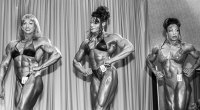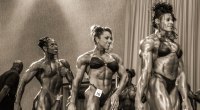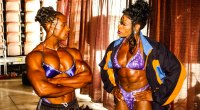Given my long history in bodybuilding, it takes a lot to impress or surprise me. But the one time that happened with Lesa Lewis.
I remember driving to a shoot in the desert with Lesa Lewis in the passenger seat. I looked over and was struck by the size and shape of her arm. I'm used to bodybuilding muscles, but this seemed special. It reminded me how impressed I was with Ronnie Coleman's arm, also huge, full and shapely. It seemed to me that this is how bodybuilding reacted to Sergio Oliva back then. When Sergio emerged in the early 1960s, he displayed incredible, never-before-seen genetics that stunned the mind!
Sergio Oliva's genetics show an arm development the size of a leg. Bill Dobbins
I first met Sergio in the 70's. He was standing outside Gold's Gym in Santa Monica wearing a short-sleeved shirt with a slit in the sleeve through which he could put his arm. His biceps were so huge and full I figured it looked like he had a leg rather than an arm sticking out of his shirt sleeve!
Although Lesa Lewis wasn't nearly as tall as Sergio or Ronnie Coleman, given her height and incredible physique, she could have been called the female version of those champions. Lesa was a genetic genius, as was Sergio, and when it comes to bodybuilding (and to some extent sport in general) genetics dictate the level and limits of achievement.
 Lesa Lewis not only had a great physique but was also a glamorous beauty. Bill Dobbins
Lesa Lewis not only had a great physique but was also a glamorous beauty. Bill Dobbins
There is a significant difference between muscles and competitive bodybuilding type muscles. Bodybuilding muscles need to be full and shapely, with lots of volume. This is something that is genetic. You can train to make your muscles bigger, but you can't change their shape.
Think of children's balloons. There are long sausage balloons and round ones. You can inflate each type of balloon as big as you like, but one will never change shape to be like the other. The same goes for muscles.
 Lisa was always up to the challenge of taking interesting photos. Bill Dobbins
Lisa was always up to the challenge of taking interesting photos. Bill Dobbins
Lesa Lewis was born in Kansas City. She grew up in a family of three brothers and three sisters. She ran track, played basketball, danced, and swam in high school. She attended the University of Nebraska-Lincoln for a year and competed in track and field as a sprinter, running the 100, 200 and 400 meters and the 400 meter relay. She left college to work as a freelance fashion designer for clothes, hats and shoes.
In 1992, Lesa began strength training at the Bally Total Fitness Gym. During that year, she trained to get fit and toned. A bodybuilder commented that she had muscular legs and told her to try bodybuilding. After that, she decided to act on his proposal and began bodybuilding training.
 Lesa Lewis in the middle of Ms. Olympia 2001 with Debbie Pariso on her left and Vickie Gates on her right. Bill Dobbins
Lesa Lewis in the middle of Ms. Olympia 2001 with Debbie Pariso on her left and Vickie Gates on her right. Bill Dobbins The 2001 Ms. Olympia. Look how tall Lesa looks compared to Iris Kyle (left) and Yaxeni Oriquen (center). Bill Dobbins
The 2001 Ms. Olympia. Look how tall Lesa looks compared to Iris Kyle (left) and Yaxeni Oriquen (center). Bill Dobbins
At the 1997 USA Championship, Lewis placed first in the heavyweight category and overall, and won her IFBB pro card. At Arnold's Ms. International 1998, Lewis placed an impressive second. The following year, Lesa won the 1998 IFBB Jan Tana competition and qualified for the upcoming Ms. Olympia competition.
 Lesa Lewis was never short of big, shapely muscles. Bill Dobbins
Lesa Lewis was never short of big, shapely muscles. Bill Dobbins
You might be wondering why, with all her genetic potential, Lesa didn't do better than her in competition. The answer is simply "conditioning". Lesa came in good shape, but not good enough for an era when women learned to be really toned, with impressive definition and musculature. Lesa Lewis missed the target and did not achieve the level of muscle strength required to be a serious contender for the Ms. Olympia title. There have been many women and men in competitive bodybuilding who have been in the same situation. You see her at the gym and think you're watching the next Ms. or Mr. Olympia. But on stage they simply lack the stamina of their competitors.
 There was probably no other female bodybuilder with more genetic potential than Lesa Lewis. Bill Dobbins
There was probably no other female bodybuilder with more genetic potential than Lesa Lewis. Bill Dobbins
This sometimes happens again, due to genetics. t everyone responds to dieting in the same way, and for many, a hard diet ends up sapping too much muscle mass or fat loss is uneven, resulting in love handles remaining.
For example. Women tend to lose fat around the waist early, while fat in the hips and butt takes a long time to lose. But I knew a female bodybuilder who lost fat below the waist early on, but had to diet so hard and for so long to sculpt her waist that all her muscle mass and shape was exhausted.
 Lesa Lewis with ten-time Ms. Olympia Iris Kyle at the 2001 Ms. Olympia. Bill Dobbins
Lesa Lewis with ten-time Ms. Olympia Iris Kyle at the 2001 Ms. Olympia. Bill Dobbins
However. In many cases, competitors aren't at their best on stage because the competitive bodybuilder's diet is just so difficult and has been described as some kind of insanity to succeed. Very low calories and cardio to achieve calorie deficit, extreme care with diet, disciplined for about sixteen weeks - while continuing hard training at the gym throughout.
So, in addition to having the right muscle genetics to become a champion bodybuilder, it also takes the right psychological mindset to train at a consistent intensity for years and withstand the psychological demands of an intense bodybuilding diet.
All of this helps emphasize how difficult it is to become a bodybuilding champion and why so many try but so few succeed. The same, of course, applies to virtually any sporting or demanding activity.
 Lesa Lewis on an abandoned tractor in the Mojave Desert. Bill Dobbins
Lesa Lewis on an abandoned tractor in the Mojave Desert. Bill Dobbins

